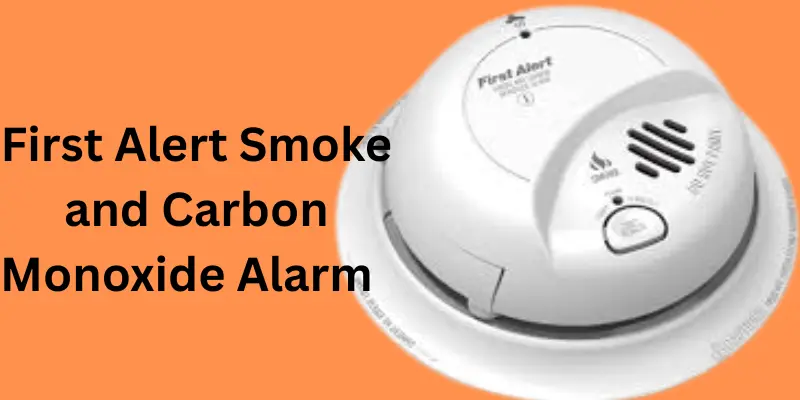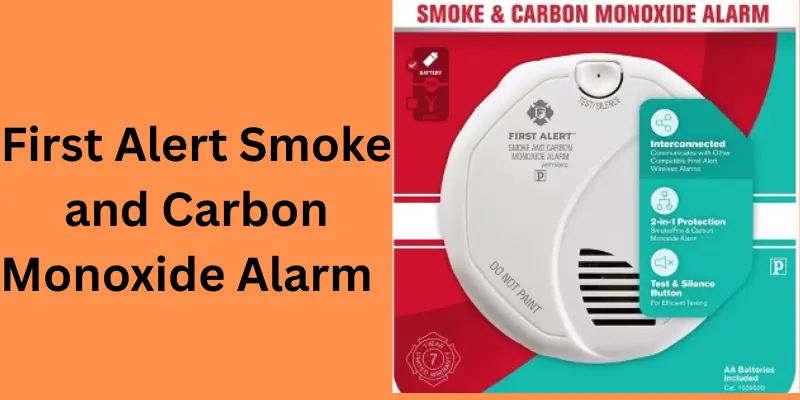First Alert Smoke and Carbon Monoxide Alarm: A Complete Guide
Updated: 15-Jun-2025
214
First alert smoke and carbon monoxide Alarm is one most important safety in this fast-paced world, ensuring your family’s safety than ever, which alerts you to life-threatening fires and invisible toxic gas leaks. Among the leading names in this sector, First Alert stands out as a pioneer in safety innovation.

Whether you’re looking to protect your home from fire hazards or prevent carbon monoxide poisoning, the First Alert Smoke and CO Alarm is a reliable and trusted choice. With intelligent design and cutting-edge features, it offers the peace of mind every homeowner deserves.
Brand Overview: First Alert
Founded in 1958, First Alert has become a household name synonymous with trust and safety. The company introduced the first residential smoke alarm and has continued to innovate with a wide range of fire safety and carbon monoxide detection solutions.
With a strong global presence and multiple certifications such as UL, CSA, and NFPA compliance, First Alert products are recognized for their quality, durability, and reliability. Whether in the U.S., Europe, or Asia, First Alert alarms are found in millions of homes, schools, and commercial buildings.
What is a Smoke and Carbon Monoxide Alarm?
A smoke and carbon monoxide alarm is a dual-function device designed to detect both smoke from fires and carbon monoxide (CO), a colorless and odorless gas that can be deadly if undetected. These devices offer dual-sensor functionality, combining photoelectric and electrochemical sensing technologies.
Unlike traditional smoke-only alarms, combo detectors provide protection from two deadly threats in one unit. This not only reduces installation complexity but also enhances safety through more comprehensive detection.
How First Alert Smoke and CO Alarms Work
First Alert alarms use advanced sensing technologies to detect threats efficiently:
- Photoelectric sensors detect smoldering fires with minimal false alarms.
- Ionization sensors respond quickly to fast-flaming fires.
- Electrochemical CO sensors provide accurate detection of carbon monoxide.
Some First Alert models offer dual-sensor alarms that incorporate both photoelectric and ionization technologies for enhanced fire detection. The electrochemical CO detection process ensures precise monitoring, reducing false alerts while maximizing protection.
Top Features of First Alert Alarms
What makes First Alert stand out is its array of advanced safety features:
- Voice alerts that differentiate between fire and carbon monoxide threats.
- Electrochemical CO sensors for precise gas detection.
- 10-year sealed battery models that require no battery changes.
- Hardwired alarms with battery backup for continuous operation during power outages.
- Wireless interconnectivity allowing multiple alarms to communicate for whole-home protection.
These features make First Alert an ideal choice for homes, apartments, and commercial spaces.
Types of First Alert Smoke and Carbon Monoxide Alarms
| Model | Type | Power Source | Features | Use Area |
|---|---|---|---|---|
| SCO5CN | Battery | Battery-operated | Basic CO + Smoke Detection | Bedrooms, Hallways |
| SC9120B | Hardwired | 120V + battery backup | Interconnects with other alarms | Entire Home |
| PRC710 | Battery | 10-year sealed battery | Photoelectric Smoke + CO Detection | Living Rooms |
| Onelink Safe & Sound | Smart | Wi-Fi + Alexa-enabled | Smart home, music, voice control | Smart Homes |
Each model caters to different needs—from basic protection to high-tech smart integrations.
Comparison with Other Brands
When evaluating safety alarms, comparing First Alert with competitors like Kidde and Nest Protect highlights its strengths.
| Feature | First Alert | Kidde | Nest Protect |
|---|---|---|---|
| Battery Life | 10 years | 10 years | 5 years |
| Smart Options | Yes (Onelink) | Limited | Full |
| Voice Alerts | Yes | Yes | Yes |
| App Control | Yes (Onelink) | No | Yes |
First Alert balances reliability, affordability, and smart features, making it a versatile and practical choice for modern homes.
Installation Guide
Proper installation is essential to ensure maximum protection. Here are the recommended guidelines:
Placement:
- Bedrooms: For quick alerts while sleeping.
- Kitchens: At least 10 feet from cooking appliances.
- Hallways: Between bedrooms and exits.
- Basements: Especially near fuel-burning appliances.
Mounting:
- Ceiling: Ideal for smoke detection (since smoke rises).
- Wall: Position alarms at least 4–12 inches from the ceiling.
Tools Required:
- Screwdriver
- Mounting brackets (included)
- Drill (for hardwired models)
Wiring vs Battery:
- Hardwired models offer interconnectivity and power consistency.
- Battery-operated models are easier to install and ideal for rentals or older homes.
Maintenance and Battery Replacement
Keeping your First Alert Smoke and CO alarm in top working condition is essential for reliable performance.
Alarm Testing Frequency
- Test alarms once a month using the test button.
- Ensure both smoke and CO functions respond with appropriate alerts.
Battery Replacement Steps
- Open the battery compartment.
- Replace with the recommended battery type (usually AA or 9V).
- For 10-year sealed models, no battery replacement is needed—replace the whole unit after 10 years.
Sensor Lifespan and Replacement
- Smoke sensors typically last 7–10 years.
- CO sensors need replacing every 5–10 years, depending on the model.
- Always check the manufacturing or replacement date on the device label.
Resetting the Alarm
- Press and hold the test/reset button until the unit resets.
- For smart models, reset can also be done via the One link app.
Troubleshooting and Common Issues
Even the best alarms can occasionally beep or signal errors. Here’s how to address the most common problems:
Beeping or Chirping Causes
- Low battery
- End-of-life warning
- Malfunction or sensor failure
Fixing False Alarms
- Avoid placing near kitchens or bathrooms (humidity or cooking fumes).
- Clean the device to remove dust or insects.
Understanding Error Codes
- Refer to the user manual for specific beeping patterns.
- Some models use voice alerts to indicate the issue (e.g., “Low Battery”).
Voice Alert Error Diagnosis
- Voice messages may include “carbon monoxide detected” or “replace alarm.”
- Check for ambient triggers or test to verify accuracy.
Top-Rated Models by First Alert
Based on consumer reviews, features, and value, here are some top picks:
- Best Budget-Friendly Model: SCO5CN Battery Combo Alarm
- Best for Smart Homes: One link Safe & Sound (Wi-Fi, Alexa, App support)
- Best for Rental Properties: PRC710 10-Year Sealed Battery Unit
Certifications and Standards
First Alert alarms are fully compliant with safety regulations and international certifications.
UL Certifications
- UL 217 for smoke detectors
- UL 2034 for carbon monoxide alarms
NFPA and Local Code Alignment
- Compliant with National Fire Protection Association (NFPA) standards
EPA CO Safety Recommendations
- Meets U.S. Environmental Protection Agency (EPA) guidelines for CO levels
Benefits of First Alert Smoke and CO Alarms
Why do millions of homeowners trust First Alert?
- Early detection of fire and gas threats
- Peace of mind with reliable alarms
- Cost-effective models for every budget
- Smart home integration for tech-savvy households
Safety Tips for Optimal Performance
Enhance the effectiveness of your alarm system with these expert tips:
- Correct Placement: Avoid placing too close to stoves or showers.
- Monthly Testing: Ensure continuous functionality.
- Avoid Nuisance Alarms: Use photoelectric alarms near kitchens.
- Maintenance Calendar: Set reminders for cleaning and testing.
Buying Guide
Not sure which model to pick? Here’s how to choose:
- Power Type: Choose between battery, hardwired, or smart Wi-Fi.
- Home Size: Larger homes benefit from interconnected or smart alarms.
- Installation Flexibility: Renters prefer battery-only; homeowners often choose hardwired.
Frequently Asked Questions (FAQs)
1. How do I silence a First Alert alarm?
Press and hold the silence button until the alert stops. For smart models, use the One link app.
2. What does a red or green light mean?
- Green: Normal operation
- Red blinking: Alarm memory or sensor issue
- Red steady: Alarm triggered recently
3. Can I replace a First Alert alarm battery myself?
Yes, unless it’s a sealed 10-year battery model.
4. How long do First Alert alarms last?
Typically 7 to 10 years, depending on the model and sensor type.
5. Are First Alert alarms compatible with other brands?
Interconnectivity may be limited; always check product compatibility.
User Reviews and Ratings
Real users praise First Alert for:
- Ease of installation
- Long battery life
- Clear voice alerts
Some criticisms include:
- False alarms in sensitive areas like kitchens
- No app support in older models
Popular sources like Amazon, Home Depot, and Walmart feature thousands of positive reviews with 4.5+ ratings.
First Alert Smart Integration (One link)
For tech-forward users, First Alert offers Onelink smart devices.
- Control via the One link app
- Compatible with Alexa and Apple Home Kit
- Sends real-time notifications to smartphones
These features elevate home safety to a whole new level.
Global Use and Statistics
More detail
CO Poisoning Prevention Stats
- Over 400 deaths/year in the U.S. are due to CO poisoning.
- Early detection by alarms could prevent 90% of fatalities (CDC data).
Global Impact of Fire Alarms
- Homes with functional smoke alarms have 50% fewer deaths in fires.
- First Alert products are installed in over 100 million homes globally.
Summary: First Alert Smoke and Carbon Monoxide Alarm
The First Alert Smoke and Carbon Monoxide Alarm is a trusted, dual-function safety device that provides early warnings for both fire and carbon monoxide threats. Known for its advanced technology, long battery life, and smart home integration, First Alert offers a wide range of models—ranging from basic battery-powered units to sophisticated smart alarms like the One link Safe & Sound. Certified to meet UL, NFPA, and EPA standards, these alarms help protect homes, families, and properties worldwide.

Whether you’re looking for budget-friendly options, hardwired interconnectivity, or Wi-Fi-enabled control, First Alert ensures reliable performance backed by strong user reviews and global reputation. With proper installation, monthly testing, and timely maintenance, First Alert alarms provide lasting peace of mind and significantly reduce the risk of fire and CO-related incidents.
20. Conclusion
First Alert Smoke and Carbon Monoxide Alarms combine reliability, innovation, and peace of mind. Whether you’re safeguarding a small apartment or a large home, First Alert offers a model to suit every need—from budget-friendly to smart integrated systems.
Don’t forget to test your alarm monthly, replace batteries (if applicable), and upgrade units every 7–10 years. Safety begins with awareness—and First Alert makes it easy.
Please Write Your Comments